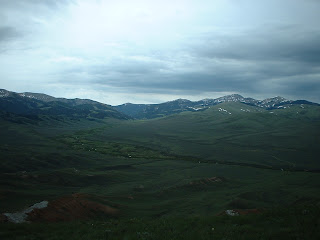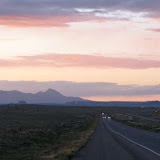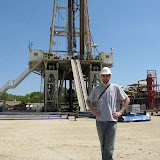MARCY DAM, JUNE 2007
After a day or two of vegging out at home I headed north for the Adirondack high peaks with my high school friend Tom and his friend Mike from college. Tom and I have been hiking together since his mom was our cub scout leader-- it's been over a decade and lots of education and growing up and all of that crap, but we still like it! Here we are at Marcy Dam on June 18:

The hike went as follows: we parked at the ADK lodge and proceeded south on the trail to Marcy Dam where we camped monday night. In the morning we were woken up by the (loud) birds so we stashed our stuff under a lean-to and hit the trail early, hiking south through Avalanche Pass and eventually to beautiful Avalanche Lake -- one of the prettyest spots in the 'dacks that I've seen. Our attemts at photogrophy basically fail to do justice to the morning light playing on the water and the walls:

VIEW NORTH OVER AVALANCHE LAKE

VIEW NORTH OVER AVALANCHE LAKE
The trail continues south around the lake on its western side. The sheer cliffs dive straight into the water at some places so the trail is on wooden planks bolted directlyi into the rock with nothing under them. Don't drop your sunglasses here, but it's a cool spot. Once you get to the south end of the lake you double back on the east side and bushwhack north through the woods for a ways until you reach a spot where boulders seem to spill out of the mountain on your right-hand site: the mouth of the dyke. Hang a right and start climbing: from here the route goes up steeply all the way to the summit of Mt. Colden and includes clambering up large boulders and rock faces followed by a slightly precarious walk up the steeply sloping slab that forms Colden's northwest slope.
After summiting Colden, we visited Indian Falls on the Way to Tabletop Mountain, which has views which can be optimistically described as very underwhelming. We hit it because it's one of the 46 peaks above 4,000 feet in the Adirondacks and it's cool if you can do them all. After Tabletop the weather started turning sour so we opted not to summit Phelps even though there was plenty of light left and we walked right bast the trail up it. We reached the lean-to at Marcy Dam just before the sky opened up poured. Lightning struck just across the pond from us and the thunder made quite a racket. After the hiking, i fell asleep in the lean-to despite the storm. As soon as it cleared we gathered our gear and rolled out towards the cars at the ADK lodge but were not fast enough: another storm broke while we were about a quarter of a mile out from the vehicles and we were completely -- and i do mean absolutely completely -- soaked through by the time we got there. Well, crap happens, you know? Anyways the ride home when fine and at the end of the day, a good time was had by all.
Since then I've been preparing for my upcoming trip to Vermont, where I will hike the Long Trail from Massachussets to Canada. This will be 270 miles. We (myself and Tom Jones, as opposed to Tom ligon who I was in the Adirondacks with...) decided to take it easy and stop to see some friends in Burlington. We will be in vermont for about a month. Preparations include the purchase and organization of gear and food, contacting folks to set up supply drops and whatnot, and my personal pet project of building an alcohol-burning stove out of Red Bull cans. The think is tiny and it rocks. We leave tomorrow.
I will update this post with more photos and links to interesting things upon my return from VT, as well as of course creating a new post regarding that trip.
Wish me luck (luck = good weather, no bears, and not running out of food).
After summiting Colden, we visited Indian Falls on the Way to Tabletop Mountain, which has views which can be optimistically described as very underwhelming. We hit it because it's one of the 46 peaks above 4,000 feet in the Adirondacks and it's cool if you can do them all. After Tabletop the weather started turning sour so we opted not to summit Phelps even though there was plenty of light left and we walked right bast the trail up it. We reached the lean-to at Marcy Dam just before the sky opened up poured. Lightning struck just across the pond from us and the thunder made quite a racket. After the hiking, i fell asleep in the lean-to despite the storm. As soon as it cleared we gathered our gear and rolled out towards the cars at the ADK lodge but were not fast enough: another storm broke while we were about a quarter of a mile out from the vehicles and we were completely -- and i do mean absolutely completely -- soaked through by the time we got there. Well, crap happens, you know? Anyways the ride home when fine and at the end of the day, a good time was had by all.
Since then I've been preparing for my upcoming trip to Vermont, where I will hike the Long Trail from Massachussets to Canada. This will be 270 miles. We (myself and Tom Jones, as opposed to Tom ligon who I was in the Adirondacks with...) decided to take it easy and stop to see some friends in Burlington. We will be in vermont for about a month. Preparations include the purchase and organization of gear and food, contacting folks to set up supply drops and whatnot, and my personal pet project of building an alcohol-burning stove out of Red Bull cans. The think is tiny and it rocks. We leave tomorrow.
I will update this post with more photos and links to interesting things upon my return from VT, as well as of course creating a new post regarding that trip.
Wish me luck (luck = good weather, no bears, and not running out of food).











